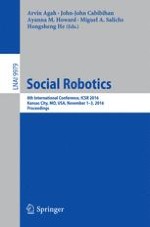2016 | OriginalPaper | Chapter
Decision-Theoretic Human-Robot Interaction: Designing Reasonable and Rational Robot Behavior
Author : Mary-Anne Williams
Published in: Social Robotics
Publisher: Springer International Publishing
Activate our intelligent search to find suitable subject content or patents.
Select sections of text to find matching patents with Artificial Intelligence. powered by
Select sections of text to find additional relevant content using AI-assisted search. powered by
